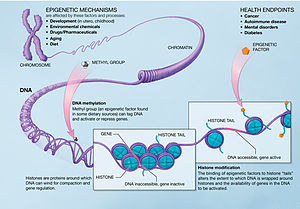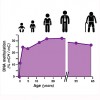Tag…You’re It!
Classic genetics alone is unable to explain the diversity we see within a population of living things. This also cannot explain how identical twins with the same DNA sequences can have differences in their traits and development of disease. First introduced in 1939 by C.H. Waddington, epigenetics is now able to offer some explanation, as it studies the heritable changes in gene expression that are not due to any alteration in the DNA sequence.
This may help to answer many questions. How can we have so many different types of cells and they all carry the same genetic information? How is it possible for one identical twin to develop cancer while the other does not? Can we use this control of the gene expression to help cells that may have lost their way?
It is amazing to think that just about all of the cells of the human body has the same DNA. The full genetic profile with all of the instructions on how to make a human is in almost every cell. When most students come through the DNA Learning Center, many of them think that there is different DNA inside of these cells. That red blood cells have different DNA than bone cells and nerve cells. One way this is done is through the interaction of small methyl groups (-CH3) that get added to the DNA molecule, which can help to silence a gene that is not needed in some type of cell or at some point of development. This is a epigenetic “tag” because there is no change to the sequence of DNA, it is just whether or not there is access to the DNA. The methyl groups that get added make the cell unable to activate that gene.
 This addition of methyl groups, called methylation, also can change throughout the course of our life. So as we get older the interaction of these groups with our DNA can change. So even with identical twins, who are born with the same DNA, their epigenetic “tags” can vary and occur independent of one another. And even more, certain lifestyle choices and experiences throughout the life of a person can change the epigenetic profile of an individual. And then this gets passed on to our children. So even what a mother eats while pregnant can affect the tags that get passed to their child. This ultimately will affect the expression of genes in the child.
This addition of methyl groups, called methylation, also can change throughout the course of our life. So as we get older the interaction of these groups with our DNA can change. So even with identical twins, who are born with the same DNA, their epigenetic “tags” can vary and occur independent of one another. And even more, certain lifestyle choices and experiences throughout the life of a person can change the epigenetic profile of an individual. And then this gets passed on to our children. So even what a mother eats while pregnant can affect the tags that get passed to their child. This ultimately will affect the expression of genes in the child.
And now we are using this information to help treat disease, such as cancer. So if a gene is turned on that shouldn’t be, could we add methyl groups to that section of the DNA to turn it off? This has started being used as a new therapy for the treatment for certain cancers.
| Print article | This entry was posted by Jennifer Galasso on January 19, 2012 at 10:28 am, and is filed under Your Genes, Your Health. Follow any responses to this post through RSS 2.0. You can leave a response or trackback from your own site. |











about 12 years ago
the wonders of science i wanna be performing this epigenetic tag therapy.